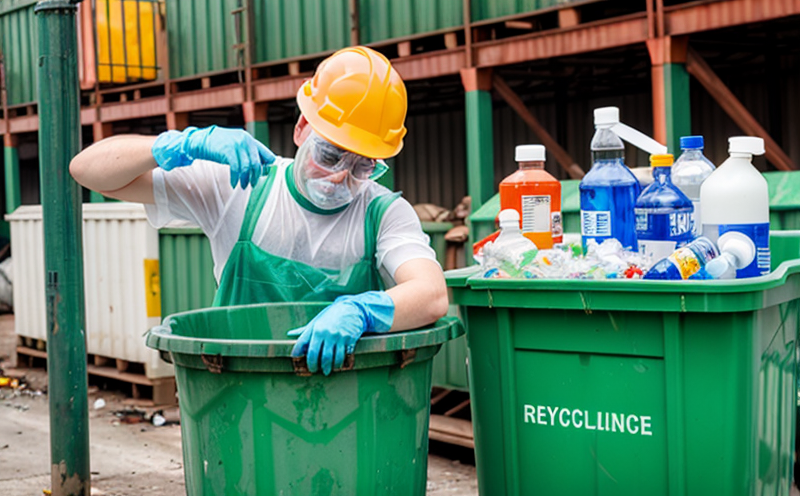EPA 1311 Toxicity Characteristic Leaching Procedure Testing
The EPA 1311 Toxicity Characteristic Leaching Procedure (TCLP) is a critical test used by the U.S. Environmental Protection Agency to determine if waste materials contain constituents that are hazardous enough to be regulated as "hazardous waste" under the Resource Conservation and Recovery Act (RCRA).
This test measures the leachable concentrations of specific metals, pesticides, polychlorinated biphenyls (PCBs), and other toxic chemicals from solid or semi-solid waste materials. The results are used to determine if a material should be managed as hazardous waste based on its toxicity characteristics.
The test involves subjecting the waste sample to a simulated leaching environment that mimics conditions found in landfills, incinerators, and other waste management facilities. The extracted chemicals are then analyzed using various analytical techniques such as atomic absorption spectroscopy (AAS), inductively coupled plasma mass spectrometry (ICP-MS), or gas chromatography-mass spectrometry (GC-MS).
Proper specimen preparation is crucial for accurate results. Samples should be collected from the waste stream, placed in appropriate containers, and transported to the laboratory under controlled conditions to prevent contamination.
The TCLP test is widely used across various industries such as manufacturing, construction, and hazardous waste management. Compliance officers and quality managers rely on this testing method to ensure regulatory compliance and protect public health and the environment.
Test Parameters
The test parameters include the volume of leachate that is extracted from the waste sample under specified conditions. The extraction process involves immersing a known weight of the waste material in a solution consisting of 50 mL of distilled water, pH adjusted to 5.5 ± 0.2 with sodium acetate buffer and acetic acid.
The leaching is conducted for four hours at room temperature (21-27°C) under continuous agitation. After the extraction period, the leachate is filtered through a 0.45 μm filter to remove any particulate matter.
Instrumentation
The instrumentation used for this test typically includes analytical balances, pH meters, stirrers, and filtration units. The laboratory also employs various chromatographic and spectroscopic techniques for the final analysis of the leachate.
The results are reported in terms of the concentration of each regulated constituent found in the leachate. These concentrations are compared against specific thresholds set by the EPA to determine if the waste should be classified as hazardous waste.
The testing process is governed by strict standards and protocols, including ISO/IEC 17025 for quality management systems of testing and calibration laboratories. Compliance with these standards ensures accurate and reliable results.
Industry Applications
- Manufacturing industries to ensure waste materials do not exceed hazardous limits
- Hazardous waste management facilities to manage waste according to RCRA regulations
- Construction and demolition sites for managing contaminated debris
- R&D laboratories developing new waste management technologies
- Manufacturers of electronic devices, who must ensure the proper disposal of circuit boards containing heavy metals.
- Hospitals that generate medical waste requiring appropriate handling based on its toxicity characteristics.
- Construction companies dealing with asbestos and lead-containing materials in demolition projects.
Eurolab Advantages
At Eurolab, we pride ourselves on delivering reliable and accurate EPA 1311 TCLP testing. Our state-of-the-art laboratory facilities equipped with the latest analytical instrumentation ensure precision in every test result.
- ISO/IEC 17025 accreditation for our laboratories
- Experienced and certified analysts
- Comprehensive quality assurance programs
- Fast turnaround times without compromising accuracy
We understand the importance of timely results in maintaining compliance with environmental regulations. Our commitment to excellence ensures that you receive accurate, reliable data when it matters most.
International Acceptance and Recognition
- The EPA 1311 TCLP test is widely recognized in the United States for its role in hazardous waste classification under RCRA.
- The test results are accepted by regulatory bodies, including state environmental agencies and federal authorities like the U.S. Environmental Protection Agency.
While this method is specific to the United States, similar tests exist internationally. For instance, ISO 15267-1:2003 outlines a procedure for determining leachate from solid waste in Europe. Although not identical, these methods share common objectives and principles.
The acceptance of EPA 1311 TCLP results extends beyond the U.S. borders as many international organizations recognize its importance for global environmental protection efforts.





